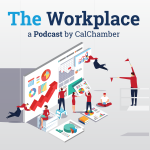In Episode 82 of The Workplace podcast, CalChamber Executive Vice President and General Counsel Erika Frank talks with employment litigation expert Kristen Nesbit, partner at Fisher Phillips, Los Angeles, about the types of COVID-19-related litigation employers are seeing and what employers can do to protect their business.
Types of Claims Filed
We are still in the early stages of the pandemic, but employers already are seeing claims being filed against them, Nesbit says. In fact, last month the law firm saw COVID-19-related litigation claims increase 43% from the previous month.
The lawsuits, she says, are a hybrid mix of issues, but the top four litigation matters Nesbit is seeing are based on:
• Discrimination;
• Failure to accommodate leave laws or work from home requests;
• Workers’ compensation/unsafe workplace (including lack of personal protective equipment); and
• Retaliation.
Out of the four, the two most common lawsuits are on discrimination and leave law conflicts. Usually these claims stem from the decisions employers make on which employees are chosen for reduced hours, laid off or furloughed, Nesbit explains. In particular, claims may come from employees who are part of a protected class and were furloughed.
Frank points out that this type of situation may occur if a pregnant employee went out on leave at the onset of the COVID-19 pandemic and was then laid off during the crisis.
Similarly, claims may arise if the employee was on a disability leave of absence under the Family and Medical Leave Act (FMLA) or California Family Rights Act (CFRA), Nesbit adds.
But the law is clear: just because an employee is in a protected class, it does not shield the employee from being a part of a reduction in force or furlough, she says.
Establish Objective Criteria
for Reduction in Force
This is why it is critical that employers use legitimate nondiscriminatory, objective reasons to justify why a worker who is in a protected category was selected for a layoff, Nesbit stresses.
When preparing for furloughs or reductions in force, employers should identify key objective criteria and go through a company analysis of the impact those choices will have on affected employees, Nesbit says. This ensures that when the employer does select workers for layoffs, the decisions can be justified objectively; otherwise, the door may be open for litigation, she cautions.
Moreover, it is important that employers have clear documentation of their decision-making process in case they have to present themselves before a judge or jury and justify their motives. The documentation also can be useful to employers so that they can do a gut check and analyze their own decisions, Nesbit explains.
For example, analyzing the lists of furloughed employees may reveal that the majority of workers are over the age of 40, or perhaps all the affected workers are men. After the analysis, the employer will then have the opportunity to reassess their motives to ensure they were not discriminatory.
Claims Based on Leave Requests
Similar to other COVID-19-related lawsuits, claims based on leave requests are a hybrid, Nesbit tells Frank. For example, she says, a gender discrimination lawsuit may be filed along with a complaint that the employee was not accommodated in their leave of absence request.
As of now, claims are not necessarily related to the Families First Coronavirus Response Act, but instead derive from the employer’s lack of flexibility or employers putting increased demands on telework employees, Nesbit explains.
Particularly in California, where many schools are expected to conduct virtual learning, Nesbit anticipates many lawsuits will arise related to leaves and failure to accommodate.
Nesbit points out that due to the pandemic, employees may have to care for sick family members or look after their children during work hours. Employers should also be aware that the burden of child care and schooling is falling mostly on mothers. So, for example, establishing practices such as setting meetings at noon, when parents have to prepare lunch for their children, may be putting a burden on their female workers.
Anticipate an Increase
in Litigation
Nesbit advises employers to make sure “you treat your employees the way you would want to be treated in the same situation.” Because COVID-19-related laws are constantly changing, she anticipates that litigation will rise. Thus, it is very important that employers are nimble, flexible and practical.
“…because when you have to explain yourself to a fact finder—whether it is to a court, to an administrative law judge, to a jury—you want them to be able to feel that these decisions were very difficult, were very thought out, and these were practical decisions that were made…” Nesbit says. “…genuinely say we worked with this employee, we tried to accommodate them, we asked them to follow our policies and protocols, and it was only then when we exhausted all the reasonable, practical things we could do as an employer that we had to make this difficult decision.”
Subscribe to The Workplace
Subscribe to The Workplace on iTunes, Google Play, Stitcher, PodBean and Tune In.
To listen or subscribe, visit www.calchamber.com/theworkplace.


